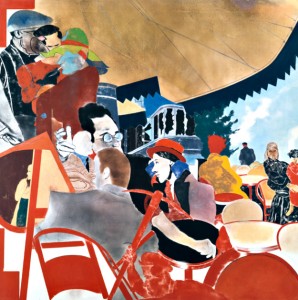Kitaj’s canvasses are riddled with references to artists and scholars, from Erasmus to Herman Melville, from Fra Angelico to Rosa Luxemburg. From a formal perspective, Kitaj’s obsessive use of citations reflects on the visual impact of images and names, signs and references. Conceptually, citations can involve finding artistic forefathers, and building an intellectual community. This is what I find particularly moving about Kitaj’s work: the artist peoples his paintings, like dream worlds, with “adopted ancestors,” who interact with one-another. → continue reading
Stay in touch
 RSS feed
RSS feed Facebook
Facebook Instagram
Instagram YouTube
YouTube
Tags
- animals archive artist art vending machine benefactor Berlin children children's books circumcision collection concept art curator diversity Europe European Maccabi Games family food France gender Germany hanukkah interview Isaac Islam Israel Judaism language letter material history memory migration NS objects people photography politics popular culture Post-War present questions rabbi showcases USA workshop World War I
Categories
- architecture (10)
- art (90)
- art vending machine (1)
- at the Jewish Museum Berlin (220)
- A Time for Everything (3)
- academy (26)
- Boris Lurie (5)
- Braginsky Collection (7)
- Cherchez la femme (5)
- First World War (7)
- forgotten objects (5)
- Fred Stein (6)
- GOLEM (7)
- Obedience (9)
- permanent exhibition (25)
- Pictures Galore and Collecting Mania (1)
- R.B. Kitaj (1932–2007). Obsessions (9)
- Snip it! (9)
- The Whole Truth (14)
- Tonalities (2)
- Welcome to Jerusalem (9)
- Beyond our own back yard (15)
- biography (6)
- Collection (33)
- conference (16)
- contemporary Jewish life (7)
- cuisine (9)
- education (21)
- film (43)
- history (105)
- holiday (18)
- literature (61)
- "New German Stories" (13)
- book week "Multifaceted" (11)
- young Jewish writers (9)
- media (16)
- museum (53)
- music (13)
- Online Collection (7)
- performance (13)
- photography (49)
- politics (39)
- Question of the Month (6)
- religion (92)
- old rituals, new customs (28)
- rabbi (2)
- Restoration (3)
- sport (21)
Blogroll
Blogerim
From the corridors
of the Jewish Museum Berlin
blog@jmberlin.de
Jewish Museum Berlin
Lindenstr. 9-14
10969 Berlin
Tel: +49 (0)30 259 93 300
